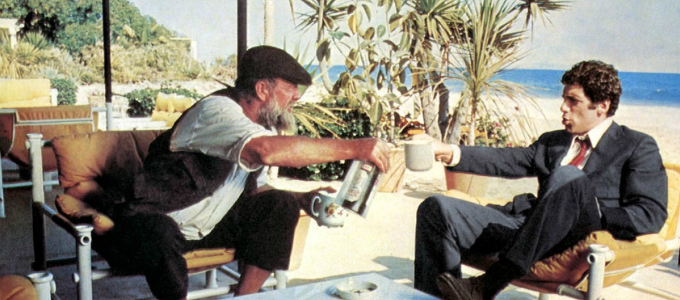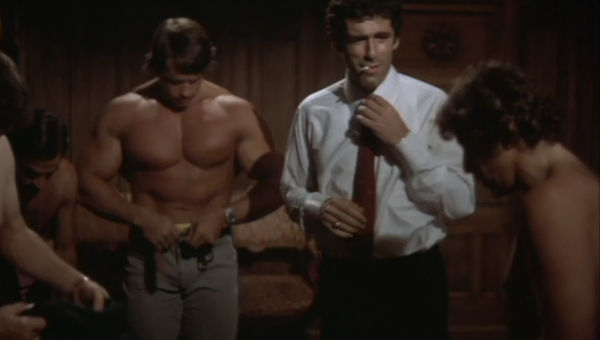 Robert Altman’s legacy has been done few favours by the documentary made in his name, much of it coming across like an uncritical ‘Making Of’ promo in a box set of the director’s Greatest Hits. By far the most interesting material in the documentary covers the early years of his career. Projects ranging from industrial films for gas stations to TV shows including Alfred Hitchcock Presents, Maverick and Bonanza all influenced Altman’s economical attitude to time and money (one half-hour episode of Whirlybirds every two days!).
Robert Altman’s legacy has been done few favours by the documentary made in his name, much of it coming across like an uncritical ‘Making Of’ promo in a box set of the director’s Greatest Hits. By far the most interesting material in the documentary covers the early years of his career. Projects ranging from industrial films for gas stations to TV shows including Alfred Hitchcock Presents, Maverick and Bonanza all influenced Altman’s economical attitude to time and money (one half-hour episode of Whirlybirds every two days!).
From this rock-solid professional platform, the visionary Altman took flight when movie opportunities came along. It wasn’t easy, though: the low-budget rocket-to-the-moon COUNTDOWN marked his first use of overlapping dialogue, enraging head of studio Jack Warner who replaced him with the producer William Conrad, the future CANNON (or ‘that fat bastard’, as James Caan calls him). It was the start of a career-long battle with studio ‘suits’, much of it exacerbated and even relished by the director himself.
Caan wasn’t well known in those days; neither were Robert Duvall and Michael Murphy, the other stars of COUNTDOWN. ALTMAN documents the director’s unconventional casting methods: the smaller parts and extras in M*A*S*H were recruited from a San Francisco troupe in 1969, before ‘improv’ lost the ‘isation’. Altman was hired after many other directors had been put off by the loose story-telling, not to mention the prospect of mounting an insolent anti-war film in the middle of the Vietnam campaign. This was all right up Altman’s street, however, and despite walk-outs over crew and locations (20th Century Fox’s backlot ranch rather than Altman’s preferred Korea) M*A*S*H survived to become a wildly successful talisman of late 60s rebellion. After that, Altman could do what he liked – notably BREWSTER McCLOUD, the story of a boy who tries to fly inside the Houston Astrodome.
Given Altman’s huge output, often made against all odds (including a heart transplant) he deserves more …
Punctuating ALTMAN are cameo appearances from stars of Altman’s movies, who summarise what ‘Altmanesque’ means to them (Robin Williams, aka POPEYE: ‘Expecting the unexpected’; Bruce Willis, featured in THE PLAYER: ‘Kicking Hollywood’s ass’). Not surprisingly, ‘self-indulgence’ and ‘letting the actors make it up as they go along’ aren’t among the one-liners, and ALTMAN offers no analysis of the director’s alternation between classics such as the unique McCABE AND MRS MILLER, and the frankly unwatchable QUINTET or PRET-A- PORTER. Instead, the documentary is bulked out with home movies and party scenes, which waste valuable time and necessitate an annoyingly linear canter through his later movies – ticked off with a critic’s admiring comment. Given Altman’s huge output, often made against all odds (including a heart transplant) he deserves more – better to read Robert Altman, The Oral Biography compiled by Mitchell Zuckoff, which puts his life and career into warts-and-all perspective.
Or look at the movies themselves. THE LONG GOODBYE is a prime example from Altman’s greatest and most innovative five-year period, which besides M*A*S*H included McCABE AND MRS MILLER, THIEVES LIKE US and NASHVILLE. On release it offended the purists, who saw Elliott Gould’s shambling and semi-focused Philip Marlowe as an insult to Raymond Chandler’s creation; with a final unforgivable outrage against Marlowe’s buddy Terry Lennox. Whereas forty years later THE LONG GOODBYE (beautifully photographed by Vilmos Zsigmond) seems to capture Chandler’s Los Angeles exactly: an LA where the streets may be mean but the lush gated communities, drying-out clinics and Malibu seafront properties are even meaner; madness and casual violence lurking at every turn.
Altman’s offbeat casting pays handsome dividends: comedian Henry Gibson as the sinister Dr Verringer, ex-baseball player Jim Bouton as Lennox and director Mark Rydell as the psychotic gangster Marty Augustine. The singer Nina van Pallandt, notoriously involved in the Clifford Irving/Howard Hughes biography hoax, made the first of her four Altman films as femme fatale Eileen Wade. John Williams’s song ‘It’s a Long Goodbye’ runs throughout: overheard in bars, the elevator, on the car radio and at a Mexican funeral, another Altman innovation. And through the whole convoluted plot ambles Elliott Gould, wearing his M*A*S*H looseness like his crumpled suit, and more bothered about his missing cat than his fifty dollars a day plus expenses. Joaquin Phoenix’s Doc Sportello is a more stoned version of Gould’s Marlowe in Paul Thomas Anderson’s INHERENT VICE, the whole movie a wonderfully-realised tribute to THE LONG GOODBYE and LA noir from the early 70s. Here’s a chance to see how once again, Robert Altman got there first.
httpvh://youtu.be/fAYheZweypk

